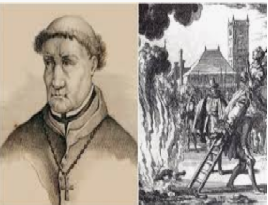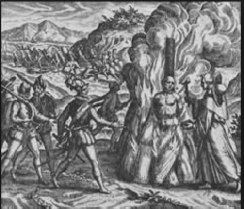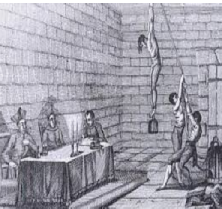|
PART 1 T O P I C |
|
|
|
|
|
|
|
|
|
|
|
|
|
|
|
|
|
|
|
CLICK BUTTON |
|
|
|
|
|
|
|
|
|
|
|
|
|
THE INQUISITION AND THE |
|
|
|
|
JewishWikipedia.info
The Inquisition can only be understood as the introduction of a religious police force by the Catholic church in conjunction with royalty, see The Medieval, Spanish, Portuguese and Roman Inquisitions and Jews in the Dark and Medieval World. It lasted for almost 600 years until their abolition in the nineteenth century. Its modern equivalent is the religious police in many Muslim countries, see Blasphemy and Apostasy in Islam
The Inquisition came into existence through the actions of Pope Innocent III at the Fourth Lateran Council in 1215 and formally endorsed by Pope Gregory IX in 1233 creating the Dominicans and then the Franciscan's as Inquisitors. In 1260 a Papal Bull redirected their allegiance from their Orders to the Pope.
Inquisitors of all countries and ages followed the same body of canon law, gave the same punishments and used the same torture and devoted themselves to the same mission - the arrest, torture and execution of any man, woman or child and dead bodies they regarded as a heretic who excited their anxieties or greed. Middle Age manuals and handbooks, were still being used six centuries later.
Henry Lea, a major authority on the Inquisition in summing up the verdict of history, states
“Fanatic zeal, arbitrary cruelty and insatiable cupidity rivaled each other in building up a system unspeakably atrocious. It was a standing mockery of justice - perhaps the most iniquitous that the arbitrary cruelty of man has ever devised.” (pp60,97)
‘Heresy’ comes from the Greek word for ‘choice’, so being a heretic is not from being accused of a crime but from having thoughts not allowed by the the church. This procedure was later described by George Orwell in his novel 1984 where he describes ‘thought crime’ as being guarded against by the ‘Thought Police’. As the dogma of the Church was still being developed it was impossible to know what was and was not allowed. Jonathan Kirsch in ‘The Grand Inquisitors Manual’ pp9 gives examples of why arrests were made and how flexible the meaning of ‘heresy’ became. It was hoped that heretics would see the falsity of their opinion and return to the Roman Catholic Church.
Many believed they did not punish anyone but were helping others to correct their errors and return them to God’s embrace. Financing the Inquisition describes why the size of the accused assets played a key role the key role in deciding who ro arrest and so the Inquisition’s existence. Their handbook described someone who managed to escape from an Inquisitorial prison as
‘one who insanely led to reject the salutary medicine offered for his care’ while the truly repentant Christian was likened to ‘a patient who took his medicine by performing without protest all the penances that had been prescribed by the good doctors of the Inquisition.’
If they were found guilty or refused they were passed to civil authorities as they had also violated civil law. The penalty included burning at the stake.
At its darkest moment, the Inquisition developed a new and even more dangerous notion: an obsession with “purity of blood” rather than “purity of faith.” With the adoption of a Spanish law that distinguished between those who had been born into Christianity and those who had converted to the faith, it was no longer sufficient or even possible for an accused herein to merely confess and repent the sin of heresy. Under the Spanish Inquisition, the conversos were regarded as ineradicably tainted by their Jewish or Muslim origins, a fact that could not be changed by confession, no matter how many names were named.
Thus did the Strictures of the Purity of blood, as a Spanish decree of 1449 was known, prefigure the Law for Protection of German Blood and Honor of 1935, Nazi Germany’s formal declaration of war on its Jewish citizenry. The “machinery of persecution,” as the Inquisition has been called by historian R. I. Moore, was now driven by race rather than religion.
The Spanish Inquisition was authorized by Pope Sixtus IV in 1478 at the request of King Ferdinand V and Queen Isabella. Sixtus also agreed its independence. It was permanently suppressed by decree on July 15, 1834. The Portuguese Inquisition was authorised in 1536 and abolished in 1821. The Roman Inquisition in the Papal States was from 1542. its last arrest was made in 1858 of a six year old Jewish boy called Edgar Mortaro. in Bologna The Inquisition had lasted for about 600 years
THE
INCREDIBLE
STORY OF THE JEWISH PEOPLE



THE INQUISITION AND THE JEWS - OVERVIEW
